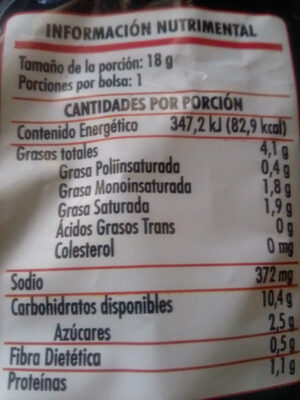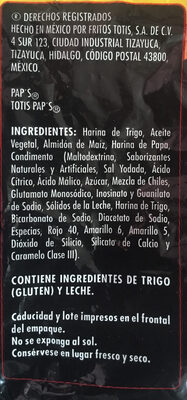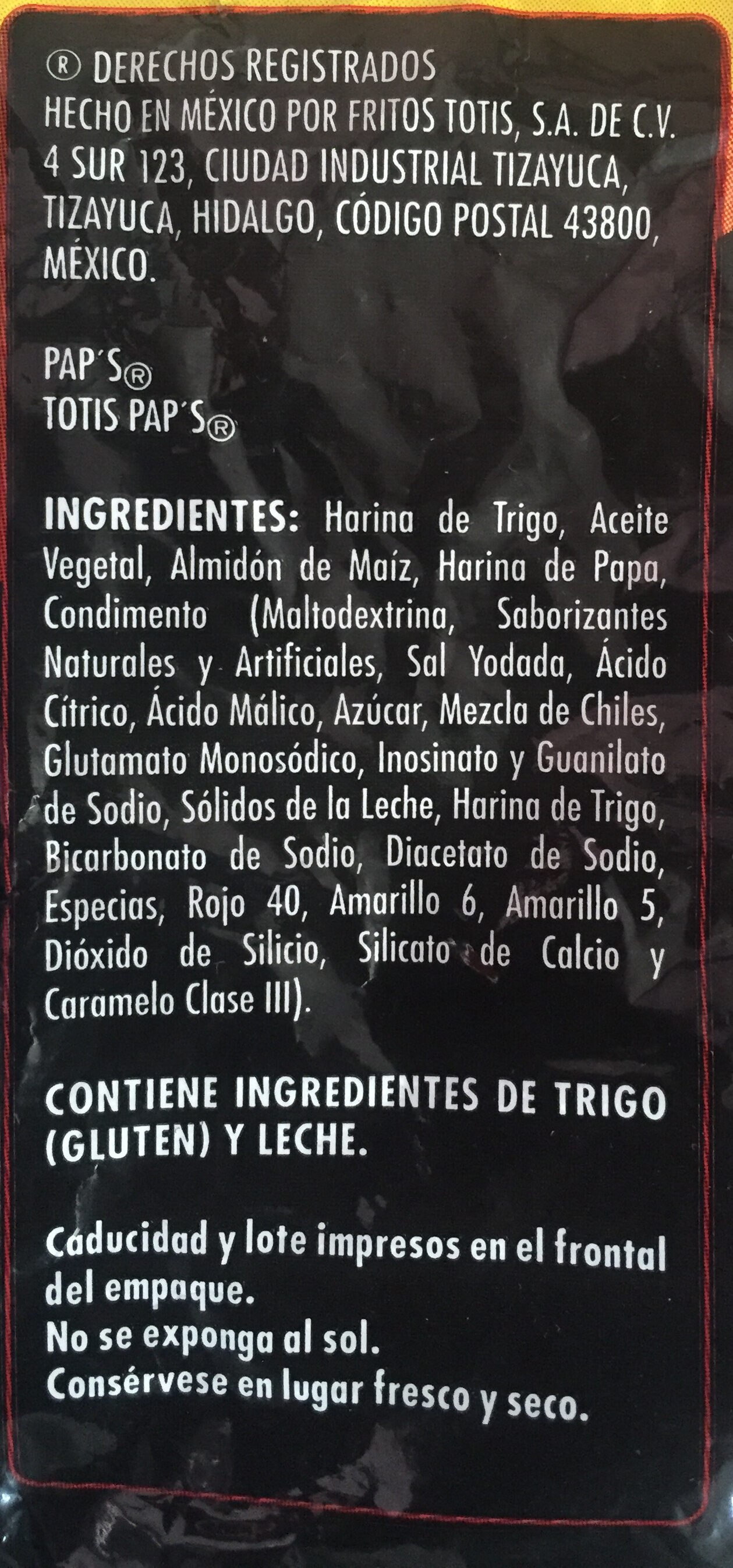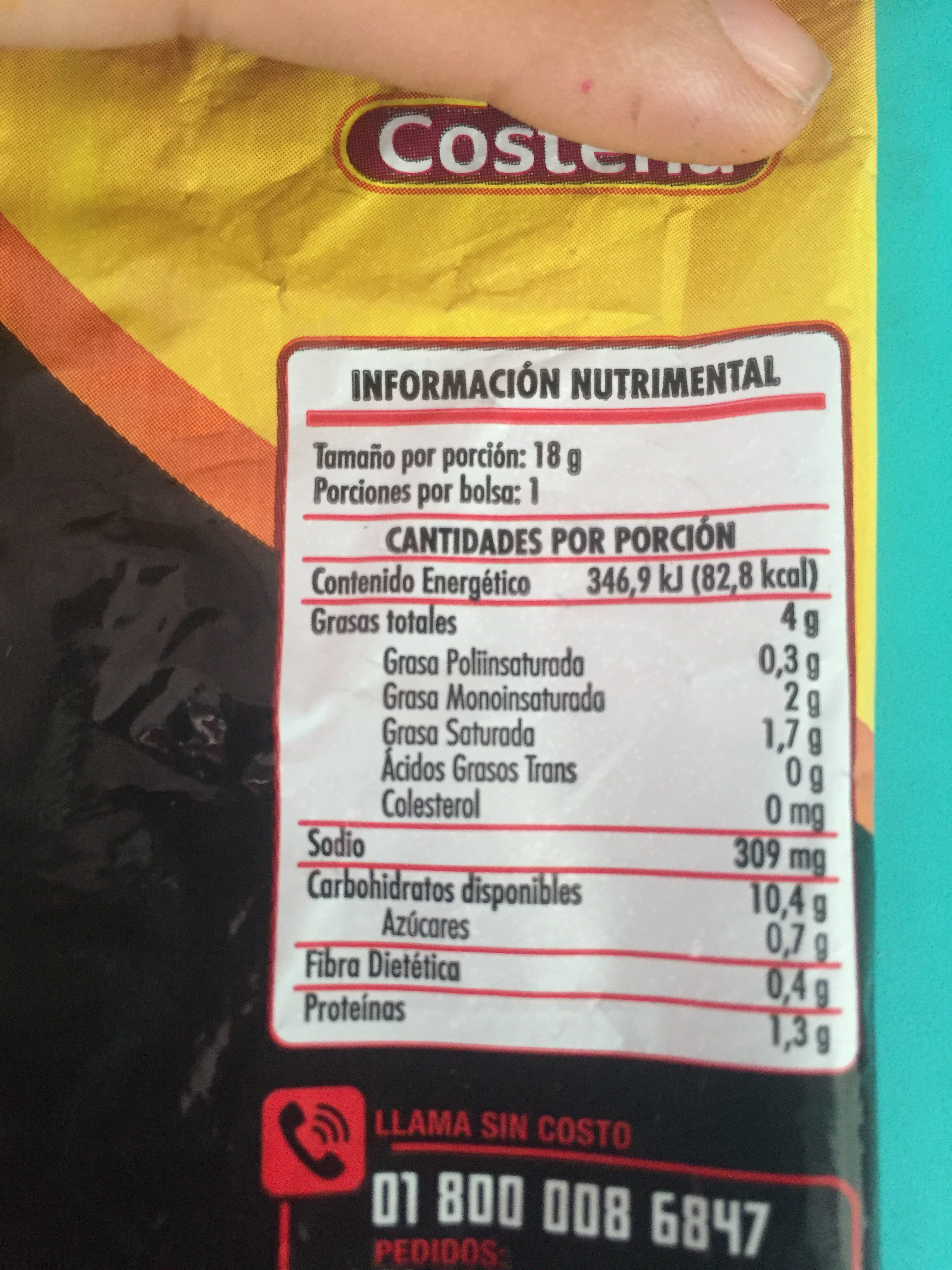Help us make food transparency the norm!
As a non-profit organization, we depend on your donations to continue informing consumers around the world about what they eat.
The food revolution starts with you!
Pap's de Totis - 18g
Pap's de Totis - 18g
This product page is not complete. You can help to complete it by editing it and adding more data from the photos we have, or by taking more photos using the app for Android or iPhone/iPad. Thank you!
×
Barcode: 0643795549684 (EAN / EAN-13) 643795549684 (UPC / UPC-A)
Quantity: 18g
Packaging: es:Celofán
Brands: Totis
Categories: Plant-based foods and beverages, Plant-based foods, Snacks, Cereals and potatoes, Salty snacks, Appetizers, Chips and fries, Crisps, Potato crisps, Flavoured potato crisps
Manufacturing or processing places: México
Link to the product page on the official site of the producer: http://totis.com.mx
Stores: Dulcerías
Countries where sold: Mexico
Matching with your preferences
Health
Ingredients
-
30 ingredients
Harina de trigo, aceite vegetal, almidón de maíz, harina de papa, condimento, maltodextrina, saborizante natural y artificiales, sal yodada, ácido cítrico, ácido malico, azúcar mezcla de chiles, glutamato monosodico, inosinato, guanilato de sodio, sólidos de leche, harina de trigo, bicarbonato de sodio, diacetati de sodio, especias, rojo 40, amarillo 6, amarillo 5, dióxido de silicio, silicato de calcio y caramelo clase lllAllergens: Gluten, Milk
Food processing
-
Ultra processed foods
Elements that indicate the product is in the 4 - Ultra processed food and drink products group:
- Additive: E102 - Tartrazine
- Additive: E110 - Sunset yellow FCF
- Additive: E129 - Allura red
- Additive: E621 - Monosodium glutamate
- Ingredient: Maltodextrin
Food products are classified into 4 groups according to their degree of processing:
- Unprocessed or minimally processed foods
- Processed culinary ingredients
- Processed foods
- Ultra processed foods
The determination of the group is based on the category of the product and on the ingredients it contains.
Additives
-
E102 - Tartrazine
Tartrazine: Tartrazine is a synthetic lemon yellow azo dye primarily used as a food coloring. It is also known as E number E102, C.I. 19140, FD&C Yellow 5, Acid Yellow 23, Food Yellow 4, and trisodium 1--4-sulfonatophenyl--4--4-sulfonatophenylazo--5-pyrazolone-3-carboxylate-.Tartrazine is a commonly used color all over the world, mainly for yellow, and can also be used with Brilliant Blue FCF -FD&C Blue 1, E133- or Green S -E142- to produce various green shades.Source: Wikipedia
-
E110 - Sunset yellow FCF
Sunset Yellow FCF: Sunset Yellow FCF -also known as Orange Yellow S, or C.I. 15985- is a petroleum-derived orange azo dye with a pH dependent maximum absorption at about 480 nm at pH 1 and 443 nm at pH 13 with a shoulder at 500 nm. When added to foods sold in the US it is known as FD&C Yellow 6; when sold in Europe, it is denoted by E Number E110.Source: Wikipedia
-
E129 - Allura red
Allura Red AC: Allura Red AC is a red azo dye that goes by several names, including FD&C Red 40. It is used as a food dye and has the E number E129. It is usually supplied as its red sodium salt, but can also be used as the calcium and potassium salts. These salts are soluble in water. In solution, its maximum absorbance lies at about 504 nm.Source: Wikipedia
-
E262 - Sodium acetates
Sodium acetate: Sodium acetate, CH3COONa, also abbreviated NaOAc, is the sodium salt of acetic acid. This colorless deliquescent salt has a wide range of uses.Source: Wikipedia
-
E262ii - Sodium diacetate
Sodium acetate: Sodium acetate, CH3COONa, also abbreviated NaOAc, is the sodium salt of acetic acid. This colorless deliquescent salt has a wide range of uses.Source: Wikipedia
-
E296 - Malic acid
Malic acid: Malic acid is an organic compound with the molecular formula C4H6O5. It is a dicarboxylic acid that is made by all living organisms, contributes to the pleasantly sour taste of fruits, and is used as a food additive. Malic acid has two stereoisomeric forms -L- and D-enantiomers-, though only the L-isomer exists naturally. The salts and esters of malic acid are known as malates. The malate anion is an intermediate in the citric acid cycle.Source: Wikipedia
-
E330 - Citric acid
Citric acid is a natural organic acid found in citrus fruits such as lemons, oranges, and limes.
It is widely used in the food industry as a flavor enhancer, acidulant, and preservative due to its tart and refreshing taste.
Citric acid is safe for consumption when used in moderation and is considered a generally recognized as safe (GRAS) food additive by regulatory agencies worldwide.
-
E500 - Sodium carbonates
Sodium carbonates (E500) are compounds commonly used in food preparation as leavening agents, helping baked goods rise by releasing carbon dioxide when they interact with acids.
Often found in baking soda, they regulate the pH of food, preventing it from becoming too acidic or too alkaline. In the culinary world, sodium carbonates can also enhance the texture and structure of foods, such as noodles, by modifying the gluten network.
Generally recognized as safe, sodium carbonates are non-toxic when consumed in typical amounts found in food.
-
E500ii - Sodium hydrogen carbonate
Sodium hydrogen carbonate, also known as E500ii, is a food additive commonly used as a leavening agent.
When added to recipes, it releases carbon dioxide gas upon exposure to heat or acids, causing dough to rise and resulting in a light, fluffy texture in baked goods.
It is generally recognized as safe (GRAS) by regulatory authorities when used in appropriate quantities and poses no significant health risks when consumed in typical food applications.
-
E621 - Monosodium glutamate
Monosodium glutamate: Monosodium glutamate -MSG, also known as sodium glutamate- is the sodium salt of glutamic acid, one of the most abundant naturally occurring non-essential amino acids. Glutamic acid is found naturally in tomatoes, grapes, cheese, mushrooms and other foods.MSG is used in the food industry as a flavor enhancer with an umami taste that intensifies the meaty, savory flavor of food, as naturally occurring glutamate does in foods such as stews and meat soups. It was first prepared in 1908 by Japanese biochemist Kikunae Ikeda, who was trying to isolate and duplicate the savory taste of kombu, an edible seaweed used as a base for many Japanese soups. MSG as a flavor enhancer balances, blends, and rounds the perception of other tastes.The U.S. Food and Drug Administration has given MSG its generally recognized as safe -GRAS- designation. A popular belief is that large doses of MSG can cause headaches and other feelings of discomfort, known as "Chinese restaurant syndrome," but double-blind tests fail to find evidence of such a reaction. The European Union classifies it as a food additive permitted in certain foods and subject to quantitative limits. MSG has the HS code 29224220 and the E number E621.Source: Wikipedia
Ingredients analysis
-
May contain palm oil
Ingredients that may contain palm oil: Vegetable oil
-
Non-vegan
Non-vegan ingredients: Milk solids, MilkSome ingredients could not be recognized.
We need your help!
You can help us recognize more ingredients and better analyze the list of ingredients for this product and others:
- Edit this product page to correct spelling mistakes in the ingredients list, and/or to remove ingredients in other languages and sentences that are not related to the ingredients.
- Add new entries, synonyms or translations to our multilingual lists of ingredients, ingredient processing methods, and labels.
If you would like to help, join the #ingredients channel on our Slack discussion space and/or learn about ingredients analysis on our wiki. Thank you!
-
Vegetarian status unknown
Unrecognized ingredients: es:saborizantes-naturales-y-artificiales, es:mezcla, es:inosinato-y-guanilato-de-sodio, es:silicato-a-de-calcio-y-caramelo-clase-iii, es:contiene-ingredientes-de-trigo, es:gļuten, es:caducidad-y-lote-impresos-en-el-frontal-del-empaque, es:no-se-exponga-al-sol, es:conservese-en-lugar-fresco-y-secoSome ingredients could not be recognized.
We need your help!
You can help us recognize more ingredients and better analyze the list of ingredients for this product and others:
- Edit this product page to correct spelling mistakes in the ingredients list, and/or to remove ingredients in other languages and sentences that are not related to the ingredients.
- Add new entries, synonyms or translations to our multilingual lists of ingredients, ingredient processing methods, and labels.
If you would like to help, join the #ingredients channel on our Slack discussion space and/or learn about ingredients analysis on our wiki. Thank you!
-
Details of the analysis of the ingredients
We need your help!
Some ingredients could not be recognized.
We need your help!
You can help us recognize more ingredients and better analyze the list of ingredients for this product and others:
- Edit this product page to correct spelling mistakes in the ingredients list, and/or to remove ingredients in other languages and sentences that are not related to the ingredients.
- Add new entries, synonyms or translations to our multilingual lists of ingredients, ingredient processing methods, and labels.
If you would like to help, join the #ingredients channel on our Slack discussion space and/or learn about ingredients analysis on our wiki. Thank you!
: Harina de Trigo, Aceite Vegetal, Almidón de Maiz, Harina de Papa, Condimento (Maltodextrina, Saborizantes Naturales y Artificiales, Sal Yodada, Ácido Citrico, Acido Málico, Azúcar, Mezcla, Glutamato Monosódico, Inosinato y Guanilato de Sodio, Sólidos de la Leche, Harina de Trigo, Bicarbonato de Sodio, Diacetato de Sodio, Especias, Rojo 40, Amarillo 6, Amarillo 5, Dióxido de Silicio, Silicato a de Calcio y Caramelo Clase III), CONTIENE INGREDIENTES DE TRIGO (GĻUTEN), LECHE, Cáducidad y lote impresos en el frontal del empaque, No se exponga al sol, Consérvese en lugar fresco y seco- Harina de Trigo -> en:wheat-flour - vegan: yes - vegetarian: yes - ciqual_proxy_food_code: 9410 - percent_min: 10 - percent_max: 100
- Aceite Vegetal -> en:vegetable-oil - vegan: yes - vegetarian: yes - from_palm_oil: maybe - percent_min: 0 - percent_max: 50
- Almidón de Maiz -> en:corn-starch - vegan: yes - vegetarian: yes - ciqual_food_code: 9510 - percent_min: 0 - percent_max: 33.3333333333333
- Harina de Papa -> en:potato-flour - vegan: yes - vegetarian: yes - ciqual_food_code: 4003 - percent_min: 0 - percent_max: 25
- Condimento -> en:condiment - vegan: maybe - vegetarian: maybe - percent_min: 0 - percent_max: 20
- Maltodextrina -> en:maltodextrin - vegan: yes - vegetarian: yes - percent_min: 0 - percent_max: 20
- Saborizantes Naturales y Artificiales -> es:saborizantes-naturales-y-artificiales - percent_min: 0 - percent_max: 10
- Sal Yodada -> en:iodised-salt - vegan: yes - vegetarian: yes - ciqual_food_code: 11058 - percent_min: 0 - percent_max: 5.25
- Ácido Citrico -> en:e330 - vegan: yes - vegetarian: yes - percent_min: 0 - percent_max: 5
- Acido Málico -> en:e296 - vegan: yes - vegetarian: yes - percent_min: 0 - percent_max: 4
- Azúcar -> en:sugar - vegan: yes - vegetarian: yes - ciqual_proxy_food_code: 31016 - percent_min: 0 - percent_max: 3.33333333333333
- Mezcla -> es:mezcla - percent_min: 0 - percent_max: 2.85714285714286
- Glutamato Monosódico -> en:e621 - vegan: yes - vegetarian: yes - percent_min: 0 - percent_max: 2.5
- Inosinato y Guanilato de Sodio -> es:inosinato-y-guanilato-de-sodio - percent_min: 0 - percent_max: 2.22222222222222
- Sólidos de la Leche -> en:milk-solids - vegan: no - vegetarian: yes - ciqual_proxy_food_code: 19051 - percent_min: 0 - percent_max: 2
- Harina de Trigo -> en:wheat-flour - vegan: yes - vegetarian: yes - ciqual_proxy_food_code: 9410 - percent_min: 0 - percent_max: 1.81818181818182
- Bicarbonato de Sodio -> en:e500ii - vegan: yes - vegetarian: yes - percent_min: 0 - percent_max: 1.66666666666667
- Diacetato de Sodio -> en:e262ii - vegan: yes - vegetarian: yes - percent_min: 0 - percent_max: 1.53846153846154
- Especias -> en:spice - vegan: yes - vegetarian: yes - percent_min: 0 - percent_max: 1.42857142857143
- Rojo 40 -> en:e129 - vegan: yes - vegetarian: yes - percent_min: 0 - percent_max: 1.33333333333333
- Amarillo 6 -> en:e110 - vegan: yes - vegetarian: yes - percent_min: 0 - percent_max: 1.25
- Amarillo 5 -> en:e102 - vegan: yes - vegetarian: yes - percent_min: 0 - percent_max: 1.17647058823529
- Dióxido de Silicio -> en:e551 - vegan: yes - vegetarian: yes - percent_min: 0 - percent_max: 1.11111111111111
- Silicato a de Calcio y Caramelo Clase III -> es:silicato-a-de-calcio-y-caramelo-clase-iii - percent_min: 0 - percent_max: 1.05263157894737
- CONTIENE INGREDIENTES DE TRIGO -> es:contiene-ingredientes-de-trigo - percent_min: 0 - percent_max: 16.6666666666667
- GĻUTEN -> es:gļuten - percent_min: 0 - percent_max: 16.6666666666667
- LECHE -> en:milk - vegan: no - vegetarian: yes - ciqual_proxy_food_code: 19051 - percent_min: 0 - percent_max: 14.2857142857143
- Cáducidad y lote impresos en el frontal del empaque -> es:caducidad-y-lote-impresos-en-el-frontal-del-empaque - percent_min: 0 - percent_max: 12.5
- No se exponga al sol -> es:no-se-exponga-al-sol - percent_min: 0 - percent_max: 11.1111111111111
- Consérvese en lugar fresco y seco -> es:conservese-en-lugar-fresco-y-seco - percent_min: 0 - percent_max: 10
Nutrition
-
Bad nutritional quality
This product is not considered a beverage for the calculation of the Nutri-Score.
Positive points: 2
- Proteins: 3 / 5 (value: 6.11, rounded value: 6.11)
- Fiber: 2 / 5 (value: 2.78, rounded value: 2.78)
- Fruits, vegetables, nuts, and colza/walnut/olive oils: 0 / 5 (value: 0, rounded value: 0)
Negative points: 28
- Energy: 5 / 10 (value: 1930, rounded value: 1930)
- Sugars: 3 / 10 (value: 13.9, rounded value: 13.9)
- Saturated fat: 10 / 10 (value: 10.6, rounded value: 10.6)
- Sodium: 10 / 10 (value: 2100, rounded value: 2100)
The points for proteins are not counted because the negative points are greater or equal to 11.
Nutritional score: (28 - 2)
Nutri-Score:
-
Nutrient levels
-
Fat in high quantity (22.8%)
What you need to know- A high consumption of fat, especially saturated fats, can raise cholesterol, which increases the risk of heart diseases.
Recommendation: Limit the consumption of fat and saturated fat- Choose products with lower fat and saturated fat content.
-
Saturated fat in high quantity (10.6%)
What you need to know- A high consumption of fat, especially saturated fats, can raise cholesterol, which increases the risk of heart diseases.
Recommendation: Limit the consumption of fat and saturated fat- Choose products with lower fat and saturated fat content.
-
Sugars in high quantity (13.9%)
What you need to know- A high consumption of sugar can cause weight gain and tooth decay. It also augments the risk of type 2 diabetes and cardio-vascular diseases.
Recommendation: Limit the consumption of sugar and sugary drinks- Sugary drinks (such as sodas, fruit beverages, and fruit juices and nectars) should be limited as much as possible (no more than 1 glass a day).
- Choose products with lower sugar content and reduce the consumption of products with added sugars.
-
Salt in high quantity (5.25%)
What you need to know- A high consumption of salt (or sodium) can cause raised blood pressure, which can increase the risk of heart disease and stroke.
- Many people who have high blood pressure do not know it, as there are often no symptoms.
- Most people consume too much salt (on average 9 to 12 grams per day), around twice the recommended maximum level of intake.
Recommendation: Limit the consumption of salt and salted food- Reduce the quantity of salt used when cooking, and don't salt again at the table.
- Limit the consumption of salty snacks and choose products with lower salt content.
-
-
Nutrition facts
Nutrition facts As sold
for 100 g / 100 mlAs sold
per serving (18g)Compared to: Flavoured potato crisps Energy 1,930 kj
(460 kcal)347.2 kj
(82 kcal)-11% Fat 22.8 g 4.1 g -25% Saturated fat 10.6 g 1.9 g +235% Carbohydrates 57.8 g 10.4 g +9% Sugars 13.9 g 2.5 g +449% Fiber 2.78 g 0.5 g -35% Proteins 6.11 g 1.1 g +1% Salt 5.25 g 0.945 g +262% Fruits‚ vegetables‚ nuts and rapeseed‚ walnut and olive oils (estimate from ingredients list analysis) 0 % 0 %
Environment
-
Eco-Score B - Low environmental impact
⚠ ️Select a country in order to include the full impact of transportation.The Eco-Score is an experimental score that summarizes the environmental impacts of food products.→ The Eco-Score was initially developped for France and it is being extended to other European countries. The Eco-Score formula is subject to change as it is regularly improved to make it more precise and better suited to each country.Life cycle analysis
-
Average impact of products of the same category: A (Score: 87/100)
Category: Potato crisps
Category: Potato crisps
- PEF environmental score: 0.22 (the lower the score, the lower the impact)
- including impact on climate change: 1.54 kg CO2 eq/kg of product
Stage Impact Agriculture
62.8 %Processing
17.3 %Packaging
10.6 %Transportation
7.1 %Distribution
2.2 %Consumption
0.0 %
Bonuses and maluses
-
Origins of ingredients with a high impact
Malus: -5
Environmental policy: -5
Transportation: 0
Origin of the product and/or its ingredients % of ingredients Impact Unknown 100 %High Chile 0 %High
-
Missing packaging information for this product
Malus: -15
⚠ ️ The information about the packaging of this product is not filled in.⚠ ️ For a more precise calculation of the Eco-Score, you can modify the product page and add them.
If you are the manufacturer of this product, you can send us the information with our free platform for producers.
Eco-Score for this product
-
Impact for this product: B (Score: 67/100)
Product: Pap's de Totis - 18g
Life cycle analysis score: 87
Sum of bonuses and maluses: -20
Final score: 67/100
-
Carbon footprint
-
Equal to driving 0.8 km in a petrol car
154 g CO² per 100g of product
The carbon emission figure comes from ADEME's Agribalyse database, for the category: Potato crisps (Source: ADEME Agribalyse Database)
Stage Impact Agriculture
53.5 %Processing
15.0 %Packaging
18.2 %Transportation
11.9 %Distribution
1.3 %Consumption
0.0 %
Packaging
-
Missing packaging information for this product
⚠ ️ The information about the packaging of this product is not filled in.Take a photo of the recycling information Take a photo of the recycling information
Transportation
-
Origins of ingredients
Origins of ingredients with a high impact
Origin of the product and/or its ingredients % of ingredients Impact Unknown 100 %High Chile 0 %High
Report a problem
-
Incomplete or incorrect information?
Category, labels, ingredients, allergens, nutritional information, photos etc.
If the information does not match the information on the packaging, please complete or correct it. Open Food Facts is a collaborative database, and every contribution is useful for all.
Data sources
Product added on by openfoodfacts-contributors
Last edit of product page on by juventinosaavedra2012.









